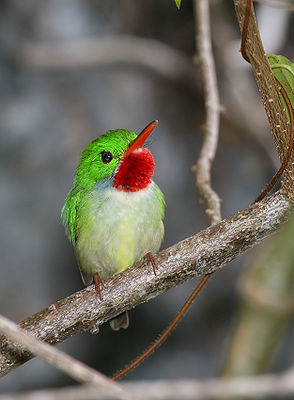Jamaikatodi
| Jamaikatodi | ||||||||||
|---|---|---|---|---|---|---|---|---|---|---|

Jamaikatodi ( Todus todus ) |
||||||||||
| Systematics | ||||||||||
|
||||||||||
| Scientific name | ||||||||||
| Todus todus | ||||||||||
| ( Linnaeus , 1758) |
The Jamaican Tody or Grüntodi ( Todus Todus ) is a bird art from the order of Coraciiformes (Coraciiformes) and the family of Todi . He is occasionally assigned to the controversial order of the kingfisher-like (Alcediniformes).
features
The Jamaikatodi is similar in shape to the other Todis. The relatively large head rests on a compact body. The tail is short and spatulate, the wings are broad. The Jamaikatodi's beak is medium-long, thin and flattened. At the top it is slightly curved downwards. His feet have four thin toes. He has a distinctive crimson throat. The top of the head, neck, wings, back and tail are iridescent green, with the lower parts of the face being lighter. The belly side is colored pale green-yellow, the underside of the tail is white. There is a short, light line above the red throat. Males have some blue spots on their necks and backs, while females wear a light half-ring on their necks. The bird's beak is two-colored: the upper half is gray-brown and the lower half is red-orange. There are short bristles at the base of the beak. Its legs are gray-brown in color. The large eyes are surrounded by a featherless, dark red ring. The iris is a strong light blue.
The Jamaikatodi becomes 11 centimeters long and weighs about 6 grams. Mostly you see him in a sitting position on a branch, while he leans his head back and tilts it upwards.
Way of life
The Jamaikatodi lives in pairs. He shows little or no fear of people and utters long, plaintive cries. It feeds mainly on insects - mainly beetles and hymenoptera - but also eats seeds. The bird sits on branches and waits for insects flying by to pounce on them from the air. Then he returns to his control room. It chops up its prey by hitting it against a branch.
The Todi creates its nest hole in an embankment. The passage to the brood chamber is about 20 to 30 centimeters long and has one or more turns to prevent enemies from entering. The brood chamber is padded with moss and other plant parts. The female lays 4 to 5 white eggs, both sexes incubate the clutch alternately. The young stay in the cave until they are fit to fly. During the breeding season, the male stubbornly defends the breeding area against other conspecifics.
Habitat and Distribution
The bird lives in subtropical mountain forests at an altitude of about 1000 meters. It occurs exclusively in Jamaica , an island in the Greater Antilles in the Caribbean .
literature
- Theo Jahn: Brehm's new animal encyclopedia . Herder Verlag, Freiburg im Breisgau, special edition for Prisma Verlag, Gütersloh 1982, ISBN 3-570-08606-2
- David Burnie: Animals - The Great Picture Encyclopedia . Dorling Kindersley Verlag, Munich 2001, ISBN 3-8310-0202-9
Web links
Web link
- Todus todus inthe IUCN 2013 Red List of Endangered Species . Listed by: BirdLife International, 2012. Retrieved February 6, 2014.